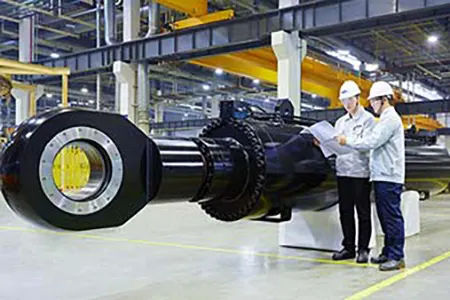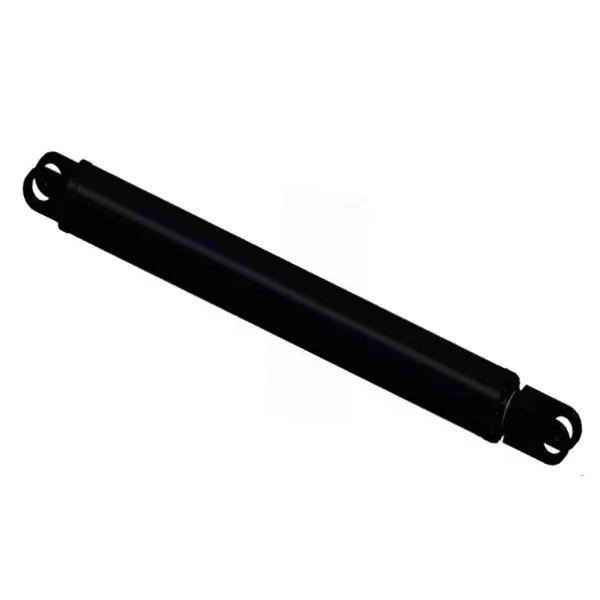Offshore Crane Main Boom Luffing Cylinder
Como cilindros hidráulicos uno de los fabricantes, los surtidores y los exportadores de productos mecánicos, ofrecemos cilindros hidráulicos y muchos otros productos.
Póngase en contacto con nosotros para más información.
Correo:sales@hydraulic-cylinders.net
Fabricante proveedor exportador de cilindros hidráulicos.
Offshore Crane Main Boom Luffing Cylinder
The offshore crane main boom luffing cylinder is a high-performance hydraulic component for offshore crane systems. This critical cylinder is pivotal in controlling the main boom’s luffing motion, providing precise and reliable lifting capabilities in demanding offshore environments. With its exceptional features and robust construction, the offshore crane main boom luffing cylinder is an indispensable tool for companies seeking to enhance efficiency, productivity, and safety in their offshore lifting operations.
The offshore crane main boom luffing cylinder is a reliable and efficient hydraulic component that enhances offshore lifting operations. Its high lifting capacity, precise control, and rugged construction ensure safe and efficient load handling in demanding offshore environments. Companies can maximize the cylinder’s performance, efficiency, and safety by following the recommended usage methods and implementing regular maintenance practices. With the offshore crane main boom luffing cylinder as a valuable asset, businesses can streamline their offshore lifting operations, improve productivity, and ensure secure and efficient load handling in critical offshore applications.
Offshore Crane Main Boom Luffing Cylinder Key Characteristics:
- High Lifting Capacity: The offshore crane main boom luffing cylinder boasts a robust hydraulic system that delivers impressive lifting capacity. It can effortlessly handle heavy loads, ensuring efficient and reliable lifting operations in offshore environments.
- Precise Control: This cylinder offers precise control over the luffing motion of the main boom. Operators can adjust the luffing angle with accuracy, allowing for optimal positioning of the load and careful maneuvering in tight spaces.
- Rugged and Corrosion-Resistant Construction: The offshore crane main boom luffing cylinder is built to withstand harsh offshore conditions. Constructed from high-strength materials and corrosion-resistant coatings, it provides exceptional durability and longevity, even in corrosive saltwater environments.
- Enhanced Safety Features: Safety is paramount in offshore lifting operations, and the offshore crane main boom luffing cylinder delivers. It has advanced safety features such as overload protection systems, emergency stop mechanisms, and fail-safe devices, ensuring secure and reliable lifting operations in critical offshore applications.
Offshore Crane Main Boom Luffing Cylinder Parameter:
| Product Name | Offshore Crane Main Boom Luffing Cylinder |
| Features: | Provides thrust force to realize the pitching of the crane boom |
| Bore diameter: | Up to 580mm |
| Rod diameter: | Up to 440mm Stroke up to 5635mm |
| Thrust force: | Maximum 8454KN (Cylinders diameter 580mm/pressure 32MPa) |
| Applications: | Offshore Crane |
Rod diameter: up to 440mm
Stroke up to 5635mm
(Cylinders diameter 580mm/pressure 32MPa)
Offshore Crane Cylinder Factory:

Usage Method Of Offshore Crane Main Boom Luffing Cylinder:
- Installation: The offshore crane main boom luffing cylinder is typically installed as a part of the crane’s central boom luffing system. Securely mount the cylinder using appropriate brackets and hardware, following the manufacturer’s guidelines and specifications for proper alignment and stability.
- Hydraulic Connections: Connect the cylinder to the hydraulic system of the offshore crane. Ensure the hydraulic lines are properly attached, and all connections are tight and leak-free.
- Control and Operation: The luffing motion of the main boom is controlled by the hydraulic system that operates the Offshore Crane Main Boom Luffing Cylinder. Operators use crane control consoles or control panels to adjust the hydraulic flow and control valves, precisely controlling the luffing angle of the main boom.
- Load Handling: When lifting loads, operators adjust the luffing angle of the main boom using the control system. The Offshore Crane Main Boom Luffing Cylinder extends or retracts accordingly, allowing for safe and efficient load-handling operations.
How Do You Rebuild A Hydraulic Cylinder?
Rebuilding a hydraulic cylinder involves disassembling and inspecting the cylinder, replacing worn or damaged components, and reassembling the cylinder with new seals and other necessary parts. Here is a general guide on how to rebuild a hydraulic cylinder:
- Safety Precautions: Before starting any work on the hydraulic cylinder, ensure the system is depressurized and any power sources are disconnected. Wear appropriate personal protective equipment (PPE) such as gloves and safety glasses to protect yourself.
- Cylinder Removal: Remove the hydraulic cylinder from the equipment or machinery. Follow the manufacturer’s instructions or consult the equipment manual for proper removal procedures.
- Disassembly: Carefully disassemble the hydraulic cylinder, taking note of the order and orientation of the parts as you remove them. Keep track of shims, spacers, or other components that need reinstalling in the correct positions.
- Inspection: Thoroughly inspect all cylinder components, including the barrel, piston, rod, seals, and other internal parts. Look for signs of wear, damage, or leakage. Ensure that the barrel and rod are not scored or bent. If any components are excessively worn or damaged, they should be replaced.
- Seal Replacement: Remove the old seals from the cylinder using appropriate tools. Replace all seals, including piston, rod, and wiper seals, with new ones compatible with the cylinder and hydraulic system. Lubricate the new seals with hydraulic oil before installation.
- Component Cleaning: Clean all disassembled components, including the cylinder barrel, piston, rod, and other parts, using a suitable cleaning agent. Remove any dirt, debris, or old lubricants. Dry the components thoroughly before reassembly.
- Reassembly: Begin reassembling the hydraulic cylinder, following the reverse order of disassembly. Install new seals, bearings, and other replacement components as necessary. Refer to the manufacturer’s specifications or consult the equipment manual for proper assembly procedures, torque values, and seal orientation.
- Lubrication: Apply a thin layer of compatible hydraulic oil or assembly lubricant to the seals, bearings, and other moving parts during reassembly. This helps ensure smooth operation and extends the life of the seals.
- Testing and Installation: Once the hydraulic cylinder is reassembled, perform a pressure test to check for leaks or abnormal operation. Reinstall the cylinder into the equipment or machinery, following the manufacturer’s instructions or equipment manual.
Capacidad de la fábrica:
(1) Montaje
We have a first-class independent research and development assembly platform. The hydraulic cylinder production workshop has four semi-automatic lifting cylinder assembly lines and one automatic tilt cylinder assembly line, with a designed annual production capacity of 1 million pieces. The special cylinder workshop is equipped with various specifications of a semi-automatic cleaning assembly system with a designed annual production capacity of 200,000 and equipped with famous CNC machining equipment, a machining center, a high-precision cylinder processing special equipment, a robot welding machine, an automatic cleaning machine, automatic cylinder assembly machine, and automatic painting production line. Existing critical equipment of more than 300 sets (sets). The optimal allocation and efficient use of equipment resources ensure the accuracy requirements of products and meet the high-quality needs of products.


(2) Mecanizado
El taller de mecanizado está equipado con un centro de torneado de carril inclinado personalizado, un centro de mecanizado, una máquina de bruñido de alta velocidad, un robot de soldadura y otros equipos relacionados, que pueden procesar tubos cilíndricos con un diámetro interior máximo de 400 mm y una longitud máxima de 6 metros.

(3) Soldadura

(4) Pintura y revestimiento
Con pequeñas y medianas líneas de cilindros automáticos de recubrimiento de pintura a base de agua, para lograr la carga y descarga automática de robots y pulverización automática, la capacidad de diseño de 4000 piezas por turno;
También disponemos de una línea semiautomática de producción de pintura para grandes cilindros accionada por cadena, con una capacidad de diseño de 60 cajas por turno.


(5) Pruebas
Disponemos de instalaciones de inspección y bancos de pruebas de primera clase para garantizar que el rendimiento del cilindro cumple los requisitos.

We are one of the best hydraulic cylinder manufacturers. We can offer comprehensive hydraulic cylinders. We also provide corresponding cajas de cambios agrícolas. We have exported our products to clients worldwide and earned a good reputation because of our superior product quality and after-sales service. We welcome customers at home and abroad to contact us to negotiate business, exchange information, and colabore con nosotros!
Visite nuestra fábrica de RV:
Haga un recorrido por nuestra fábrica de RV con lo siguiente
¿Cómo funciona el cilindro hidráulico de una carretilla elevadora?
Cilindro hidráulico Aplicación:



